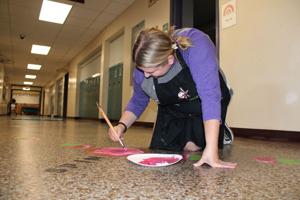
Fortunately, the school had a sensory path where the principal took the pupil, resulting in a more focused and calmer little boy. A sensory path is a series of guided movements for kids to follow, shown by markings on the ground or walls. As students follow the path and complete the movements, they work off excess energy and develop their gross motor skills, according to the Children’s Health Council.
The various movements on a path are often designed to engage different parts of the body and brain, from frog hops to spins and wall pushes. These paths can be especially effective for students who experience frustration, anger, or other sensory overloads during a learning activity. Sending them out to the hall to work off some of those emotions can help them refocus when they return to their desk.

At Pleasant Avenue Elementary School, art teacher Jamie Sedal-Amman paints over a sensory path refurbishing the hallway for the pre-kindergarten through first grade building. Originally placed there in 2018, school counselor Jessica Hayner said the sensory paths promote social and emotional health. “The paths stimulate the brain,” Hayner said.
“By using bright colorful shapes, the alphabet and numbers, this permits the student to be successful throughout the day.” Sensory paths are found in school hallways or on playgrounds, from pre-K through middle schools. Good sensory paths have a wide variety of physical elements for children to try and often include some learning concepts like counting or the alphabet.
They’re colorful and engaging and tough enough to stand up to lots of jumping feet, day after day. The Children’s Health Council suggests trying vinyl decals or even duct tape in the inside and paint to create paths on the playground or sidewalk on the outside. “These paths approach the whole mind and body, making them curious and able to explore,” Hayner said.
.














